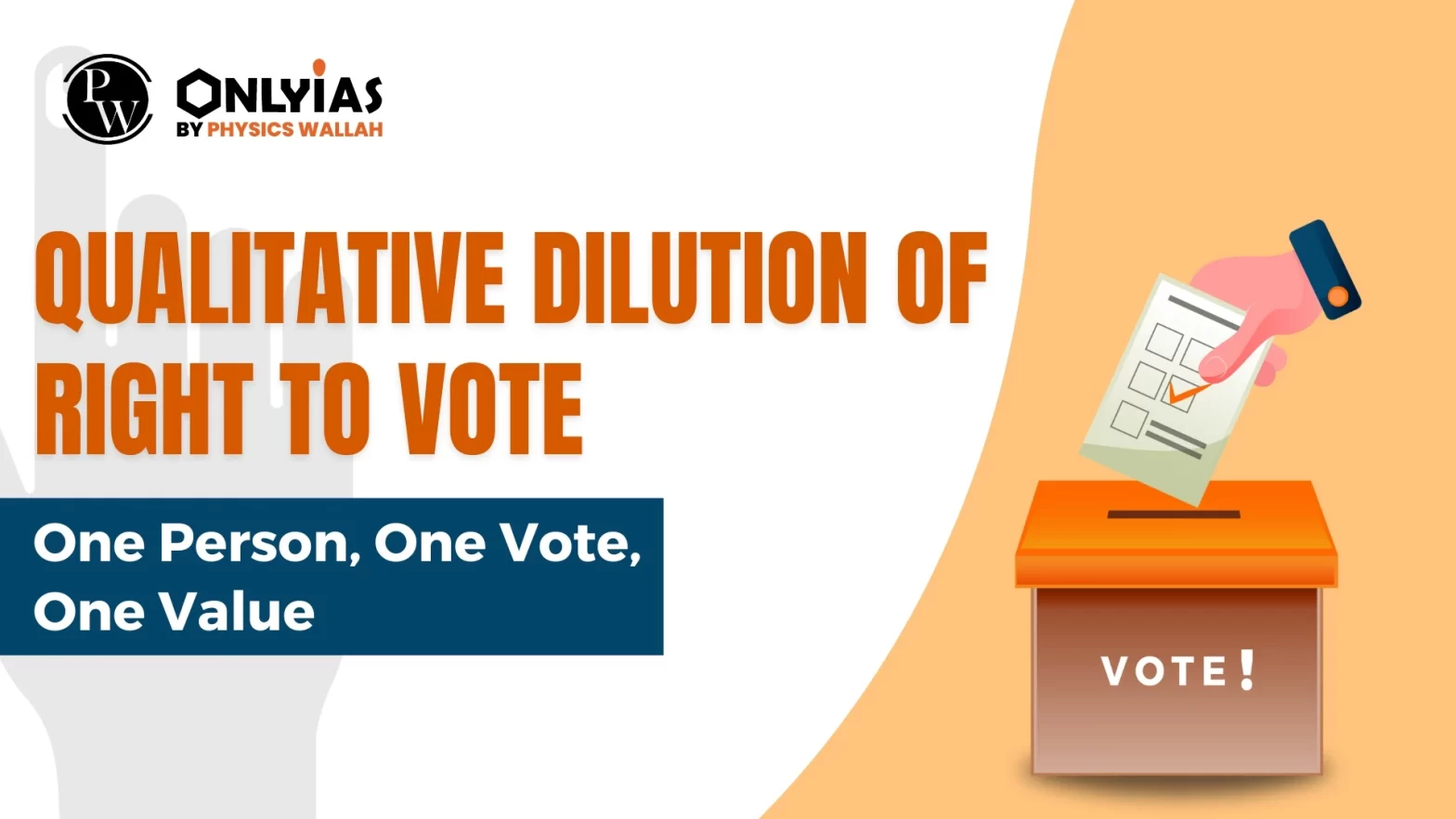Context: This article is based on an Editorial “One person, one vote, one Value” which was published in the Hindu. Political equality in liberal democracy deals with the equality of opportunity to participate in the political decision-making process and carry a vote value that is equal to that of other members of the community. However, the dilution of the right to vote is a rising concern for India.
| Relevancy for Prelims: Right to Vote, Delimitation Commission, and associated Constitutional Provisions.
Relevancy for Mains: Dilution of Right to Vote, Its Challenges and the Way Forward. |
About Delimitation of Constituencies
- For Equal Representation of Population: It is an act of redrawing boundaries to represent changes in population to provide equal representation to equal segments of a population.
- Impact on Democracy: It plays a major role in strengthening or weakening democracy.
- Universal Adult Suffrage in India: It is the right to vote of all adult citizens and as per Article 325 of the Constitution, no person shall be ineligible for inclusion in an electoral roll on grounds of religion, race, caste, or sex.
- On a Regular Basis: Delimitation of constituencies needs to be carried out regularly based on the decennial Census to maintain equality of the vote value.
- An Independent Commission: Based on Article 327 of the Constitution, the government forms an independent delimitation commission headed by a retired Supreme Court judge to avoid qualitative dilution.
Continue Reading: Delimitation of Constituencies
Formation of Delimitation Commissions: The government has constituted four delimitation commissions so far in 1952, 1962, 1972, and 2002.
- Delimitation Commission of 1956: It identified 86 constituencies as two-member constituencies, which was abolished by the Two Member Constituencies (Abolition) Act, 1961.
- Delimitation Commission of 1967: It increased the number of Lok Sabha seats from 494 to 522 and State Assembly seats from 3,102 to 3,563.
- Delimitation Commission of 1976: It increased the number of Lok Sabha and State Assembly constituencies to 543 and 3,997, respectively.
- Enactment of 42nd Amendment Act, 1976 to counter the imbalance of representation and froze the population of the 1971 Census for delimitation until after the 2001 Census.
- Delimitation Commission of 2002: It allowed up to 10% variation in the parity principle. It increased the number of seats for SCs and STs based on the increase in population. The moratorium was extended till the 2026 Census for any further increase in the number of seats.
About Dilution of Right to Vote: As per scholar Pamela S. Karlan, the right to vote can be diluted quantitatively and qualitatively by redrawing the boundaries of the constituency.
- Quantitative Dilution: It happens when votes receive unequal weight due to huge deviations in the population among the constituencies.
- Example: Due to population differences, in Uttar Pradesh, an MP represents around 2.53 million people, while in Tamil Nadu, an MP represents around 1.84 million people.
- Qualitative Dilution: It happens when a voter’s chance of electing a representative of their choice is reduced due to gerrymandering (redrawing of boundaries to favor a candidate/party).
- It can be used as a tool to sideline the votes of minorities by following the three ways:
- Cracking: Areas dominated by minorities are divided into different constituencies.
- Muslim majority block in Purnia, Bihar was divided across different constituencies in the 2010 delimitation process to reduce Muslim influence.
- Stacking: The minority population is submerged within constituencies.
- As per the Sachar Committee report, in Mangalore, Karnataka Muslim populations were combined with larger Hindu populations across assembly segments, submerging their voting power.
- Packing: Minorities are packed within a few constituencies.
- In 2008 Delhi delimitation, areas with high Muslim populations were packed into fewer constituencies, to reduce their sway in other seats.
- Such steps have a major impact on the number of Muslim representatives in Parliament. Presently, the share of Muslim MPs is only around 4.42%, while their population is 14.2%.
Constitutional Provisions Against Dilution of Right to Vote
- Articles 81 and 170 of the Constitution: The ratio of the population for the Lok Sabha and State Legislative Assembly constituencies shall be the same as far as practicable.
- Article 327 of the Constitution: It empowers Parliament to make laws related to the delimitation of constituencies, which cannot be questioned in a court of law.
- Articles 330 and 332 of the Constitution: It guarantees reservation of seats for Scheduled Castes (SCs) and Scheduled Tribes (STs) in Parliament and State Legislative Assemblies, which need to be kept in mind during delimitation.
Also Read: ELECTION COMMISSION OF INDIA (Article 324 – 329)
The Path Ahead
- No further postponing of the Delimitation as it will lead to more deviation in the population-representation ratio.
- The next Delimitation Commission needs to address qualitative dilution so that minorities are represented more adequately.
- The interests of the southern States have to be protected as they have less representation in Parliament in comparison to the northern states of India.
Conclusion:
Timely and fair delimitation is crucial to prevent the dilution of the right to vote, ensuring equal representation, and protecting the interests of all voters in India.
| Prelims Question (2017)
Right to vote and to be elected in India is a?
(a) Fundamental Right
(b) Natural Right
(c) Constitutional Right
(d) Legal Right
Ans: (c) |
![]() 18 Dec 2023
18 Dec 2023

